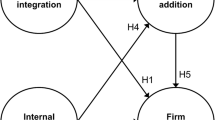Abstract
Economic Value Added (EVA®) and corresponding value driver trees are prevalent frameworks of value-based management to measure and analyse shareholder value creation. However, they are explanatory models from an operations research perspective and do not provide decision support for performance optimisation. In this paper, we develop a comprehensive value-based decision framework for mid-term sales and operations planning (S&OP) in the supply chain implementing EVA as the objective function. The pivotal element of our framework is a decision-oriented extension of EVA-based value driver trees bridging the gap to the decision variables of S&OP as the operational performance levers. We utilise a numerical example to highlight the significant improvement potential due to the value-based optimisation approach. Working capital management emerges as the major mid- to short-term value driver in the supply chain.





Similar content being viewed by others
References
Bertel S, Fenies P and Roux O (2008). Optimal cash flow and operational planning in a company supply chain. Int J Comput Integr Manuf 21: 440–454.
Brealey RA, Myers SC and Marcus AJ (2009). Fundamentals of Corporate Finance. McGraw-Hill: Boston.
Christopher M and Ryals L (1999). Supply chain strategy: Its impact on shareholder value. Int J Logist Mngt 10: 1–10.
Comelli M, Fenies P and Tcherneva N (2008). A combined financial and physical flows evaluation for logistic process and tactical production planning: Application in a company supply chain. Int J Prod Econ 112: 77–95.
Dyson RG (2000). Strategy, performance and operational research. J Opl Res Soc 51: 5–11.
Feng Y, D'Amours S and Beauregard R (2008). The value of sales and operations planning in oriented strand board industry with make-to-order manufacturing system: Cross functional integration under deterministic demand and spot market recourse. Int J Prod Econ 115: 189–209.
Fleischmann B, Meyr H and Wagner M (2008). Advanced planning. In: Stadtler H and Kilger C (eds). Supply Chain Management and Advanced Planning: Concepts, Models, Software, and Case Studies. Springer: Berlin, pp 81–106.
Grimson A and Pyke DF (2007). Sales and operations planning: An exploratory study and framework. Int J Logist Mngt 18: 322–346.
Guillen G, Badell M and Puigjaner L (2007). A holistic framework for short-term supply chain management integrating production and corporate financial planning. Int J Prod Econ 106: 288–306.
Kannegiesser M, Günther H-O, van Beek P, Grunow M and Habla C (2009). Value chain management for commodities: A case study from the chemical industry. OR Spectrum 31: 63–93.
Kaplan RS and Atkinson AA (1998). Advanced Management Accounting. Prentice-Hall: Upper Saddle River.
Kirca Ö and Köksalan MM (1996). An integrated production and financial planning model: An application. IIE Trans 28: 677–686.
Kleijnen JPC and Smits MT (2003). Performance metrics in supply chain management. J Opl Res Soc 54: 507–514.
Lambert DM and Pohlen TL (2001). Supply chain metrics. Int J Logist Mngt 12: 1–20.
Merzifonluoglu Y, Geunes J and Romeijn HE (2007). Integrated capacity, demand, and production planning with subcontracting and overtime options. Nav Res Logist 54: 433–447.
Nobes C and Parker RB (2008). Comparative International Accounting. Prentice-Hall: Harlow.
Rappaport A (1998). Creating Shareholder Value: A Guide for Managers and Investors. Free Press: New York.
Shapiro JF (2007). Modeling the Supply Chain. Thomson-Brooks/Cole: Belmont.
Vollmann TE, Berry WL, Whybark DC and Jacobs FR (2005). Manufacturing Planning and Control for Supply Chain Management. McGraw-Hill: Boston.
Walters D (1999). The implications of shareholder value planning and management for logistics decision making. Int J Phys Distrib Logist Mngt 29: 240–258.
Young SD and O'Byrne SF (2001). EVA and Value-based Management: A Practical Guide to Implementation. McGraw-Hill: New York.
Acknowledgements
We thank the two anonymous referees for their valuable feedback that helped to improve the paper significantly.
Author information
Authors and Affiliations
Corresponding author
Rights and permissions
About this article
Cite this article
Hahn, G., Kuhn, H. Optimising a value-based performance indicator in mid-term sales and operations planning. J Oper Res Soc 62, 515–525 (2011). https://doi.org/10.1057/jors.2010.96
Received:
Accepted:
Published:
Issue Date:
DOI: https://doi.org/10.1057/jors.2010.96




